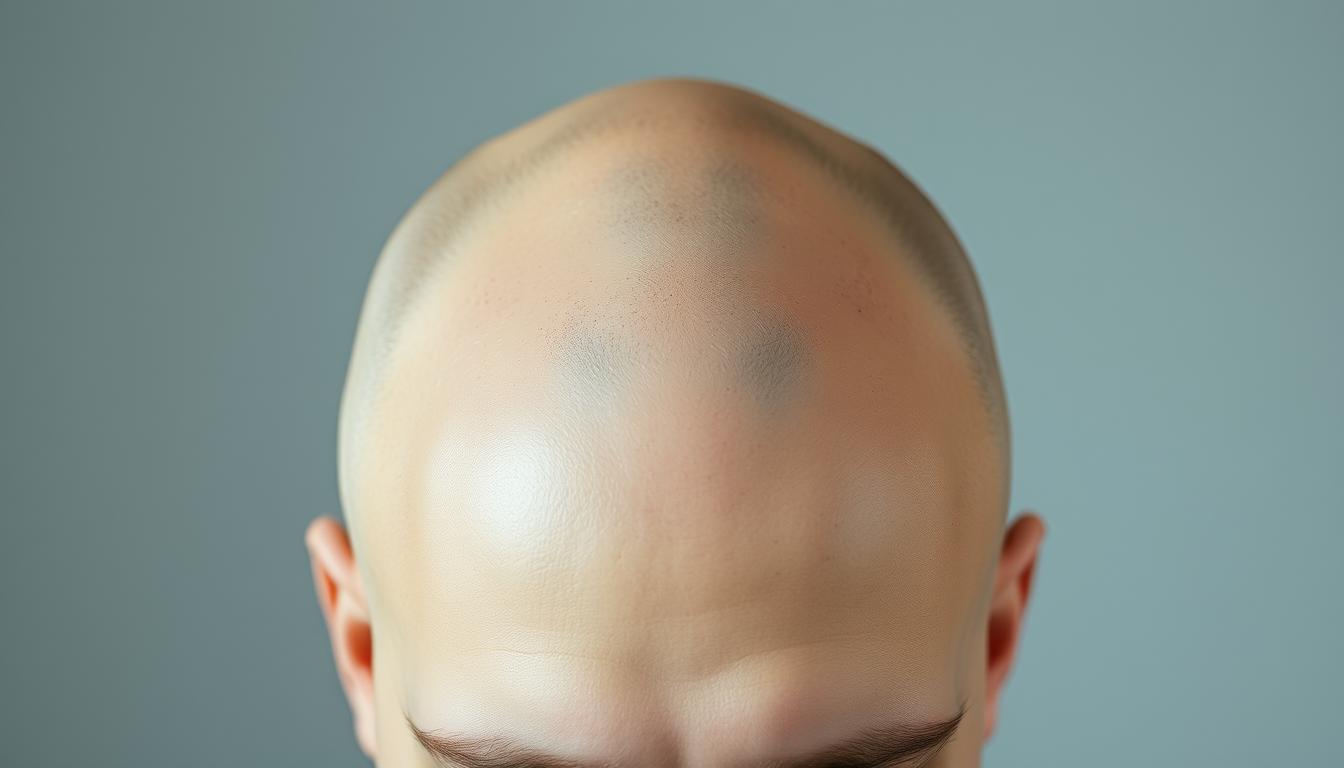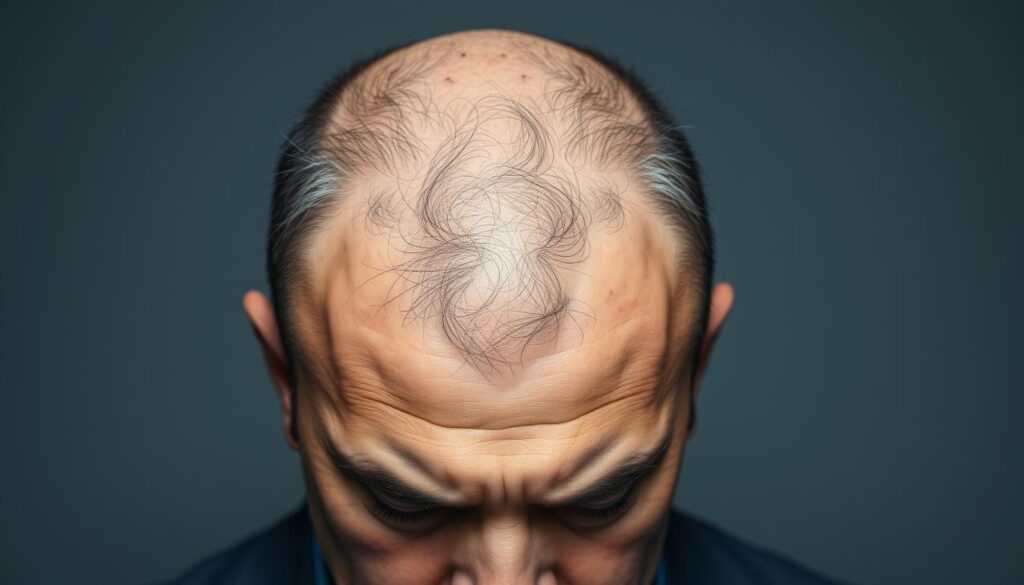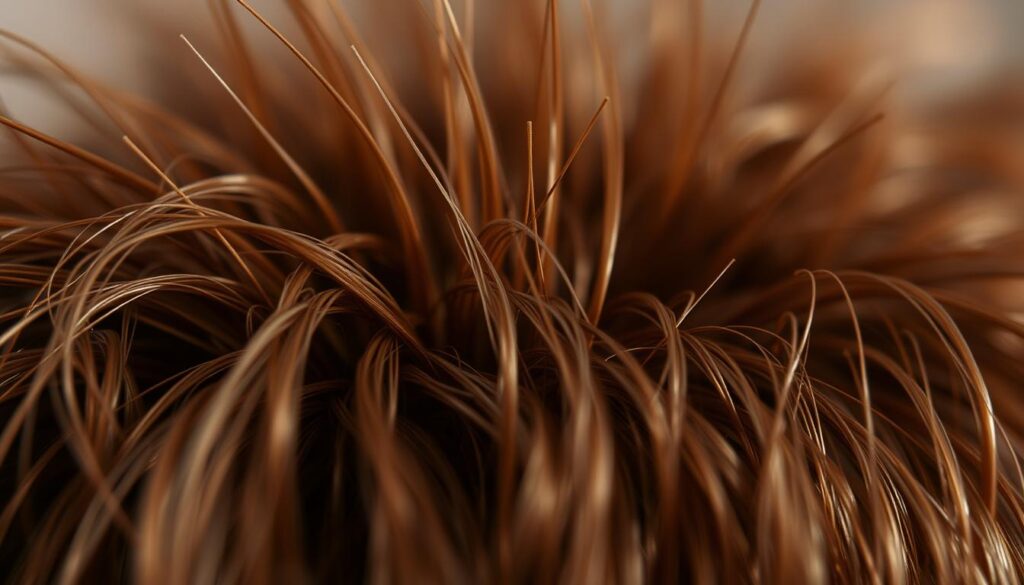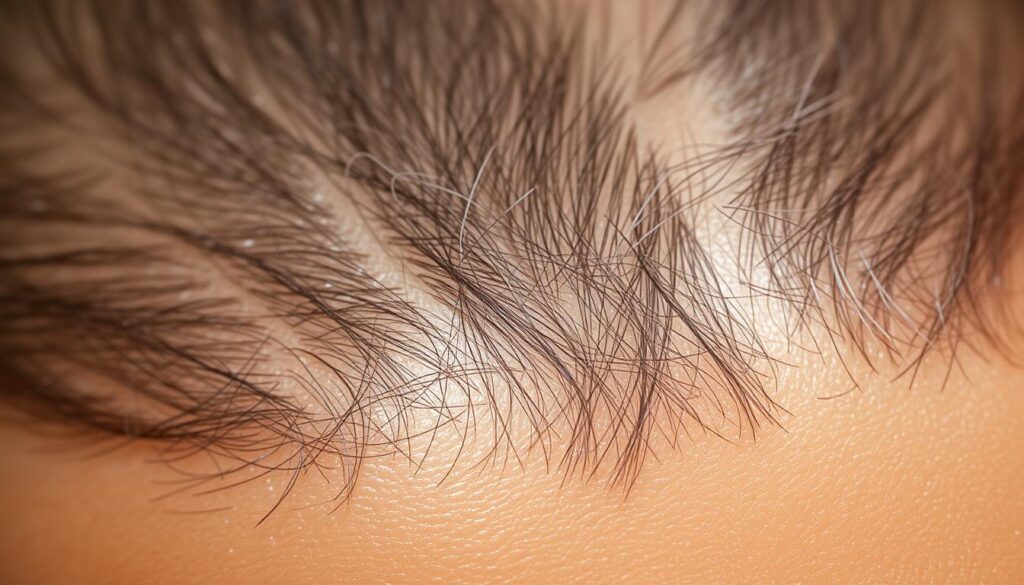
This guide helps men choose a short cut that fits their head shape and daily life. Many guys face hair loss or balding at the crown, and that change can hit confidence fast. Owning the look often feels better than chasing thin coverage.
We’ll show practical options: the best cuts for top and crown patterns, barber tricks to reduce contrast, and simple scalp care for a smooth finish. Short cuts and shaved heads pair well with stubble or beards—think Jason Statham—to create a neat, confident image.
You can jump to styles, causes, or treatments depending on your goal. This list covers quick wins like cuts and products, plus longer-term, evidence-based options for male pattern baldness. Whatever you choose—from shaved to textured—there’s a modern, flattering option to match your vibe.
Key Takeaways
- Short cuts and shaved looks often reduce contrast and look cleaner day to day.
- Find a cut that matches your crown pattern and face shape for a sharper look.
- Barber techniques and products can draw attention away from thin areas.
- Quick styling wins exist, and evidence-based treatments offer long-term choices.
- Confidence improves when you own the head you have instead of hiding it.
Own the look: why going bald can be your most confident style move today
Choosing to shave your head can simplify mornings and sharpen your overall presence. It removes the stress of masking thinning and turns hair loss into a deliberate, strong look.
Short cuts and full shaves reduce contrast between fuller sides and a thinner top or crown. That shift often makes men appear younger and more athletic.
Face shape matters. Square and oval heads tend to suit a clean head best. Rounder faces can balance the change with neat stubble or a full beard.
“Owning the head you have changes how others see you and how you carry yourself.”
- Shave regularly, moisturize daily, exfoliate weekly.
- Use SPF to protect exposed scalp areas.
- Try a short buzz first, then move to a full shave when comfortable.
| Look | Maintenance | Best for |
|---|---|---|
| Short buzz | Weekly clip, light moisturizer | Testing the shape, mild balding |
| Full shave | Daily shave, daily moisturizer, SPF | Clear, low-contrast image |
| Shave + beard | Shave routine + beard grooming | Adds jawline structure, balances round faces |
Confidence feeds confidence. Many men adopt the clean head as a signature, not a fallback. When you own the change, attention shifts from thin areas to your face and overall style.
Best haircuts for balding men right now

Pick a cut that reduces contrast and fits your routine. Below are practical options for men who want a clean, modern look while managing thinning hair on the top and crown.
Shave it clean: clean‑shaven head and shaved with beard combo
Who it suits: extensive loss or high contrast between top and hair sides.
Why it works: a smooth head removes visual distractions. Pairing it with stubble or a beard adds balance and jawline definition. Maintain with regular shaving, moisturizer, and SPF.
Buzz cut and crew cut: low‑maintenance winners
Buzz cut: experiment with guard lengths to reduce see-through on top. Uniform length hides thin patches and needs weekly trims—think Jason Statham for reference.
Crew cut: keep slightly more length on top and add texture to create density. A tapered or faded hair sides blend temple recession and sharpens the overall look.
Short Caesar and push‑forward crop
Short Caesar fringes mask a receding hairline with a choppy front. The push‑forward crop works for mild frontal thinning—push hair forward to soften the line, but avoid it if the scalp shows through clearly.
Slicked back with a fade, bro flow, and top knot
Slicked back with a fade: best when the front is strong but the crown is thin. Use mousse or gel and a high fade to blend recession.
Bro flow & top knot: longer hair strategies suit wavy or curly men with decent frontal coverage. A loose top knot can hide small crown spots, but avoid tight tying to prevent traction alopecia. Rotate styles to limit damage.
- Quick rule: the more visible the scalp on top, the shorter the cut should be.
- Practical tip: match your haircut to daily upkeep—if you want low effort, buzz or shave.
Bald hairstyle
A simple practical test tells you when to switch from longer hair to a full shave.
Timing test: if styling takes constant effort and your scalp shows at the crown or top, it’s time to go bald instead of balding. Moving sooner avoids the see‑through phase that draws attention and can age your look.
When to choose a full shave
Shaving fully is recommended when spots are large or contrast is high. It streamlines grooming and often looks cleaner than patchy coverage.
Maintenance tips for a smooth, healthy scalp
Build a simple routine: trim down, shave with a sharp razor or quality electric, rinse with cool water, then moisturize. Exfoliate gently 1–2 times weekly to cut ingrowns and flaking.
Daily care: apply broad‑spectrum SPF every morning and check the scalp for moles or changes. New shavers may see sensitivity—use a fragrance‑free, soothing moisturizer and ease into a daily shave.
| Task | Frequency | Why it matters |
|---|---|---|
| Shave or trim | Every 1–3 days | Keeps a consistent, low-contrast head |
| Moisturize | After every shave | Reduces irritation and dryness |
| Exfoliate | 1–2 times weekly | Prevents ingrowns and flakes |
| SPF | Daily | Protects exposed scalp from sun damage |
Pair a shaved head with short stubble or a fuller beard to balance face shape. With practice, the routine becomes faster than styling thinning hair and helps men manage male pattern hair loss with confidence.
Styles to avoid with significant hair loss

Not every coverup helps when the crown or top shows through. Some approaches only draw attention to thin areas. This short guide flags common traps and better alternatives.
The power donut and the power-donut combover
The “power donut” is hair around the sides and back with a clear ring of loss at the crown or top. In normal light this contrast often looks older and messy.
Most men get a cleaner result with a short, uniform cut or a shave. The combover variation tries to sweep hair over the ring — and usually fails in motion or wind.
See-through combovers and long hair with a bare crown
See-through combovers expose bald spots when you move or face bright light. They draw the eye to the issue instead of hiding it.
Long hair with a bare crown looks unbalanced. If you must keep length temporarily, use a beanie only in casual settings and plan a shorter transition soon.
Braids, cornrows, and locs on sparse hair
Tight braids and locs pull at fragile follicles and can cause traction alopecia. This makes existing hair loss worse and highlights empty areas.
Ask your barber for an honest read. If you can see clear scalp through styled hair in natural light, it’s time to shorten the cut.
| Pitfall | Why it fails | Better choice |
|---|---|---|
| Power donut / combover | High contrast at crown ages the face | Buzz, crew cut, or full shave |
| See-through combovers | Expose bald spots in wind/light | Short, textured crop with a fade |
| Tight braids / locs | Traction alopecia, worsens hair loss | Loose cuts or short back-and-sides |
Practical rule: the more significant the balding, the shorter and simpler the cut should be. Shorter length reduces contrast, saves time, and makes facial features and beard shape stand out.
Face shapes, beards, and how to balance your look
The right facial hair and cut guide the eye where you want it. Pairing short facial hair with a clean head adds jaw structure and pulls attention toward your eyes and cheekbones.
Pairing a shaved head with stubble or a full beard
Short stubble is universally flattering. It frames the lower face without overwhelming it and keeps focus off a receding hairline.
Fuller beards add presence for longer or rounder faces. Keep the sides tidy so the beard doesn’t widen the lower face. Clean lines at the neckline and mustache area are essential.
Choosing buzz, crew, or high and tight by jawline and head shape
A buzz cut highlights sharp features and suits square jaws. A crew cut with a touch of length on top softens very angular lines and still looks neat.
The high and tight gives strong sides and a crisp silhouette. It emphasizes the upper head and crown shape while keeping the overall look structured.
- Avoid tall quiffs if your hairline recedes; opt for forward texture or short fringes to draw attention away from the hairline.
- Experiment with beard guards at home to find a length that frames your face without overpowering it.
- Glasses add symmetry and polish when paired with a trimmed beard and short cut.
| Face/Head Shape | Recommended Cut | Beard Tip |
|---|---|---|
| Square | Buzz or high and tight | Short stubble to define jawline |
| Round | Crew cut with slight top length | Fuller beard to add vertical balance |
| Long/Rectangular | Crew cut or textured crop | Trimmed sides; keep length under chin |
| Oval | Most short cuts work well | Any tidy beard style; maintain clean edges |
Simple rule: use facial hair and smart haircuts to draw attention to the eyes and jaw, not the hairline. Keep edges tidy and experiment until the look fits your head and daily routine.
Products that help disguise thinning areas on top

A few targeted products can quickly change how your top and crown read from a distance. Use them to reduce contrast, add texture, and make short cuts look denser without heavy styling.
Hair fibers and thickening sprays for instant density
How they work: fibers cling to existing strands via an electrostatic charge, creating instant density that moves naturally. They work best on short cuts and mild thinning areas on the top and crown.
Application tip: apply after styling products, tap in fibers, then mist lightly to lock them. Pick a shade that matches your root color.
Spray-on pigments and scalp micropigmentation
Spray-on hair pigments temporarily reduce contrast between hair and scalp, helping small bald spots blend under everyday lighting. They wash out but are quick and discreet for events.
Scalp micropigmentation (SMP) is a non-surgical, permanent pigment technique that mimics shaved hair follicles. Choose an experienced specialist to avoid unnatural dots and get a natural look.
Thickening shampoos and key ingredients
Look for formulas with keratin or polymers for added lift and body. Some shampoos include caffeine, which has evidence for slowing hair loss in male pattern cases; botanical DHT blockers like saw palmetto need more research.
- Test products in your routine for rain and sweat resistance; modern fibers hold well but try them before an important day.
- Use these tools to complement, not replace, a cut that minimizes contrast.
- Do trial runs before events and apply sparingly—less is more to avoid a dusty finish.
- Match products to your lifestyle: washing frequency, gym habits, and hat use all affect choice.
Male pattern baldness and other causes of hair loss explained
Different causes make hair loss look different — and that changes how you respond. Below is a clear, short guide to common drivers so men can spot patterns and act early.
Genetics and hormones: why some heads thin at the crown and hairline
Male pattern baldness (androgenetic loss) is genetic and hormone driven. Sensitivity to DHT shortens growth phases and shrinks hair follicles, producing visible thinning at the hairline and crown over time.
Alopecia areata, scalp conditions, and scarring alopecia
Alopecia areata is autoimmune and causes sudden, round patches that can show anywhere on the scalp or face. Scalp infections or psoriasis cause red, scaly shedding that often clears with treatment.
Scarring alopecia destroys follicles and prevents regrowth. Early diagnosis by a dermatologist is vital to limit permanent loss.
Mechanical causes: tight styles, top knots, and friction
Tension from tight braids, top knots, or constant rubbing can cause traction alopecia. Reducing pull and swapping harsh accessories often helps recovery if caught early.
“Spotting the pattern matters: a widening crown or M-shaped hairline points to pattern baldness; smooth patches suggest autoimmune causes.”
Action step: seek professional evaluation — dermoscopy and basic labs can identify the exact cause and speed effective treatment.
Evidence‑based treatments for hair loss

Choose therapies that target hormones, blood flow, or cell activity to support regrowth on the scalp.
Finasteride lowers DHT, the hormone that shrinks follicles in male pattern baldness. It is a first‑line oral option and works best when used continuously. Stopping the drug usually returns the previous loss rate, so ongoing use is common.
Minoxidil widens small vessels and extends the growth phase. Applied twice daily, it can thicken miniaturized hairs on the top and crown. Microneedling (dermarolling) can boost topical uptake and add a healing stimulus when done correctly.
PRP and low‑level laser support
PRP injects concentrated platelets from your blood into thinning areas to deliver growth factors that may improve hair growth cycles. Low‑level laser therapy (LLLT) uses red or near‑infrared light to stimulate cellular activity and often needs months of consistent use to show density gains.
Corticosteroids for autoimmune shedding
For sudden patchy loss like alopecia areata, corticosteroid injections or topicals reduce inflammation and can prompt regrowth. These are not standard for pattern baldness and are used when an autoimmune cause is diagnosed.
Hair transplant options: FUE vs. FUT
Transplants move healthy follicles from the permanent donor zone to the crown or top. FUE harvests individual grafts; FUT removes a strip. Results are permanent for the grafts placed, but the underlying pattern remains. Most surgeons recommend continuing medical therapy after surgery to protect native hair.
- Expect timelines: most treatments take several months to show change.
- Combine wisely: meds, devices, and procedures often work best together.
- See a pro: consult a qualified clinician to match therapy to diagnosis, goals, and tolerance.
Barber‑tested tactics to draw attention away from thinning hair
Barbers use shape, contrast, and texture to guide where people look on your head. Small choices—fade height, top length, or a clean side part—decide whether eyes land on your face or on thin spots.
Fades, texture, and side parts that flatter
Fades tighten the hair sides so the contrast with a thinner top or crown is softer. This keeps a modern, clean look and moves focus toward facial features.
Add texture on top with point cutting or a light clay. Texture creates the illusion of fullness and avoids clumping that reveals the scalp.
Use a side part only when density allows. Place the part on the fuller side to draw attention away from sparse areas.
How to avoid see‑through spikes and combovers
See‑through spikes and combovers emphasize gaps and fail in wind or bright light. Keep top length conservative—just enough for texture without flopping or exposing scalp.
Try forward or slightly asymmetric styling to lead the eye away from the crown. Tidy necklines and clean transitions make the overall look deliberate, not hiding.
- Match product to goal: light clays for texture, low‑shine creams for control.
- Bring clear photos to your barber — they’ll translate visuals into the right taper and top length.
“Control where you draw attention — lead the eye to your best features and away from thin spots.”
For alternative cuts that blend length and contrast, consider a modern two‑block option like the two-block haircut to balance sides and top.
Daily care for a great‑looking scalp and hair

Daily care focuses on protection, moisture, and gentle handling to keep the scalp and hair in top shape. A simple routine prevents irritation and keeps your head looking intentional.
Moisturizing, exfoliating, and SPF for shaved heads
Moisturize right after shaving with a fragrance‑free lotion to calm the skin and stop flaking. Exfoliate gently 1–2 times weekly to reduce ingrowns and rough patches.
Apply broad‑spectrum SPF every morning to the exposed head and ears. Reapply when you’re outdoors for long periods to prevent burns and long‑term damage.
Heat styling, product choices, and gentle washing routines
Limit hot tools on thinning areas; high heat makes fragile strands break and accelerates loss. Use mild shampoos that cleanse without stripping natural oils.
Choose matte, lightweight products so hair won’t clump and reveal scalp. Towel‑dry gently and avoid aggressive brushing while hair is wet.
- Set a simple schedule: shave or trim, moisturize daily, exfoliate weekly.
- Try a short scalp massage for a few minutes each day to boost circulation.
- Rotate hats and avoid tight ties to reduce traction on fragile areas.
- Do regular skin checks; see a clinician for any persistent irritation or unusual spots.
| Task | Frequency | Why it matters |
|---|---|---|
| Moisturize | Daily | Soothes skin and prevents dry flakes |
| Exfoliate | 1–2× weekly | Reduces ingrowns and rough texture |
| SPF | Every morning | Protects against sun damage |
Simple routines win: a calm scalp supports comfort and a confident look while you manage thinning or hair loss.
Style playbook: from work to weekend with confidence
A small playbook of cuts and accessories keeps your presentation sharp from Monday meetings to Saturday plans. It’s about choosing a few reliable looks you can repeat without fuss.
Clean business cuts vs. rugged casual looks
Business‑friendly options include tight fades, crew cuts, and a neat side part when density permits. These read polished and keep the focus on your face in meetings.
For weekends, lean into buzzes, a shaved head, or a short, rugged stubble. These looks read relaxed and confident with minimal effort.
Smart accessories: hats, glasses, and grooming that elevate
- Wardrobe pairings: crisp button‑downs and clean edges for work; tees and a trimmed beard for off‑duty.
- Eyewear: bolder frames add presence to a short or shaved head and balance features.
- Hats: structured caps or fedoras polish an outfit; beanies work for casual cover in cold weather.
- Grooming: keep necklines, sideburns, and brows tidy. Low‑shine products read neat in the office.
- Longer hair note: if you use longer hair, keep the sides trimmed so length doesn’t fight your silhouette.
Practical tip: pick 2–3 go‑to looks to rotate. Consistency and clean lines deliver more confidence than complicated styling.
For a modern transition that balances sides and top, consider a contemporary fade haircut to keep your look intentional and balanced.
Conclusion
For most men, a tidy, pared-back cut delivers more confidence than trying to cover sparse top areas. Short, low‑maintenance haircuts and clean shaves usually beat see‑through styles for hiding crown spots and reducing contrast.
Pick a look that minimizes contrast — buzz, crew, Caesar, or a full shave — and pair it with beard shape, a fade, and texture to guide the eye where you want it.
Targeted products like fibers or SMP can mask spots while you explore evidence‑based options: finasteride, minoxidil, PRP, LLLT, or transplants. Get a clear diagnosis if your pattern seems sudden or odd.
Keep daily care simple: SPF, moisturize, gentle washing, and checkups. Visit your barber to tailor haircuts balding men can wear proudly, then act now — simpler routines bring better confidence every day.
